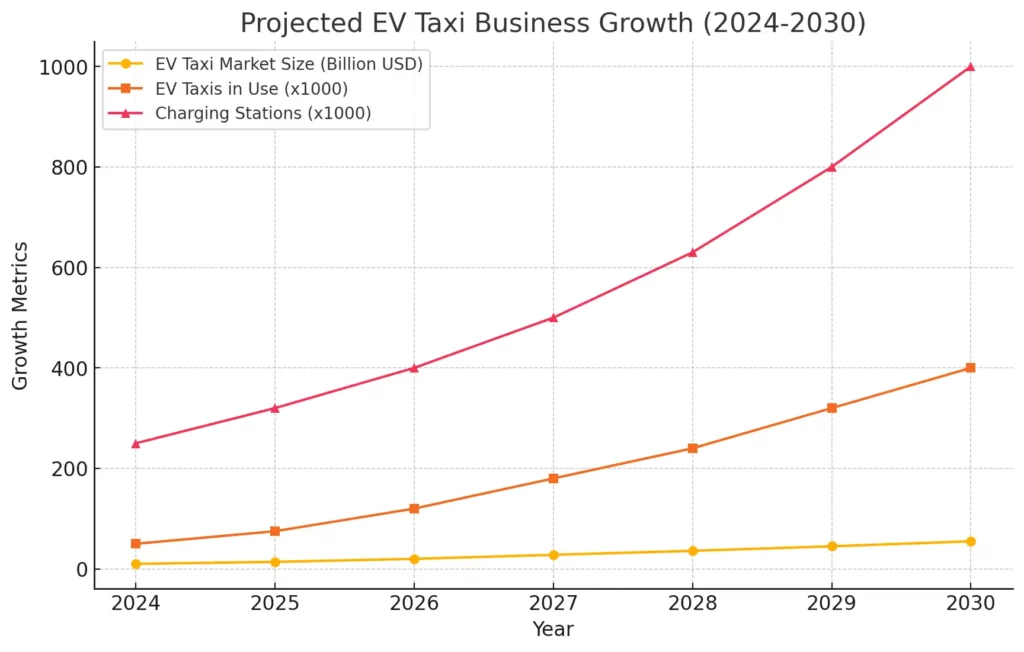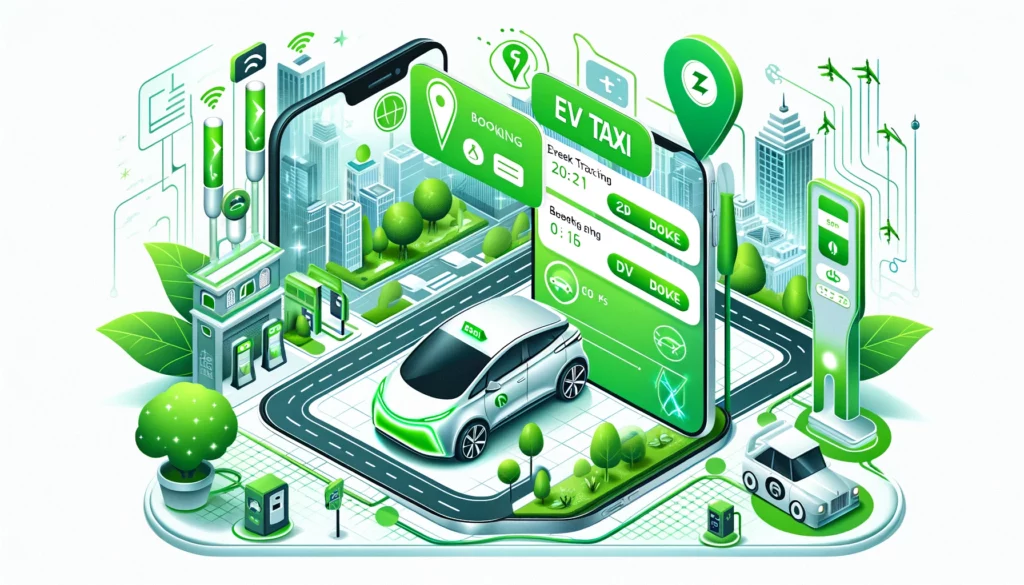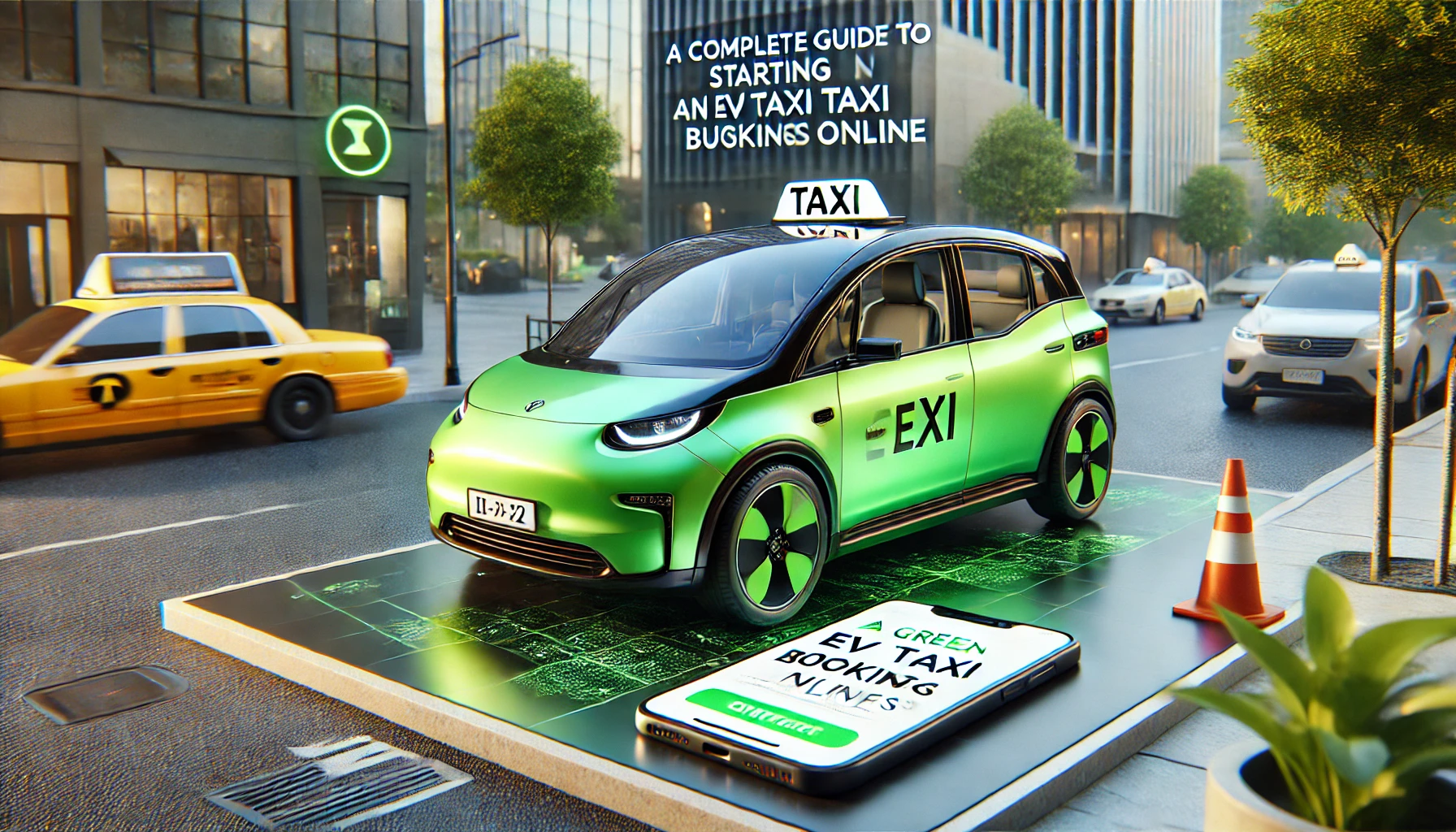As the world embraces sustainable transportation, electric vehicles (EVs) have surged in popularity. The demand for eco-friendly taxi services is rising, making it an ideal time to start an EV taxi booking business. This guide provides a comprehensive overview of how to build and launch a successful electric taxi service online, from planning and technology to marketing and customer engagement.
Why Start an EV Taxi Booking Business?
With the increasing focus on sustainability and reducing carbon footprints, green transportation businesses have emerged as a profitable and socially responsible venture. Here’s why starting an EV taxi booking app is a smart move:
- Eco-friendly alternative: Electric taxis offer a green solution to the traditional taxi service, appealing to environmentally conscious customers.
- Lower operational costs: EVs have lower maintenance and fuel costs compared to conventional vehicles.
- Government incentives: Many governments offer incentives for EV businesses, reducing initial setup costs.
- Growing market: The demand for online cab booking services that prioritize sustainability continues to grow.
Market Trends for EV Taxi Businesses
The global electric vehicle (EV) market is experiencing significant growth, with the demand for electric taxis being a key contributor. Several factors are driving the growth of EV taxi services:
- Government Regulations and Incentives: Governments worldwide are imposing stricter emissions regulations and offering incentives such as tax credits and subsidies for EV purchases and EV infrastructure. This is encouraging taxi businesses to switch from traditional vehicles to electric ones.
- Consumer Awareness: With growing environmental awareness, more customers are opting for green transportation options like EV taxis. Consumers are willing to pay a premium for eco-friendly services, creating a new segment in the taxi industry.
- Cost Efficiency: Electric taxis have lower operational costs, primarily due to cheaper fuel and lower maintenance expenses. As battery technology improves, EVs will continue to become more affordable.
- Charging Infrastructure Expansion: The global expansion of charging stations, coupled with fast-charging technology, is making EV taxis more viable, reducing the range anxiety that once limited their adoption.
- Urbanization and Smart Cities: Increasing urbanization and the development of smart city projects are boosting the demand for online cab booking services. EV taxis are being integrated into smart city infrastructure as a sustainable transportation solution.
According to recent reports, the global adoption of electric vehicles is expected to increase rapidly, driven by government incentives and sustainability goals source.
EV Taxi Business Market Trends (Projected Growth from 2024 to 2030)
Chart to represent the growth trends in the EV taxi business, focusing on global revenue, the increase in electric taxi adoption, and charging infrastructure expansion.
Projected EV Taxi Business Growth (2024-2030)

Here is the chart showing the projected growth of the EV taxi business from 2024 to 2030. The data reflects the growth in market size, the increase in the number of EV taxis in use, and the expansion of charging stations, all of which highlight the strong upward trends in the electric taxi industry.
Case Studies: Successful EV Taxi Businesses
Real-life examples can significantly boost the credibility of your EV taxi business venture. Let’s take a look at some companies that have successfully implemented green transportation and made a substantial impact in the market:
1. Uber Green: Leading the Charge in Eco-Friendly Rides
Uber launched Uber Green, a service offering electric and hybrid vehicles for passengers who prefer an environmentally friendly ride. Uber Green is available in major cities globally and is part of Uber’s larger goal to become a zero-emission mobility platform by 2040. By providing customers with an eco-friendly option, Uber has attracted a growing number of environmentally conscious users, increasing their market share in green transportation.
2. Tesla Taxis: Revolutionizing Luxury EV Rides
Tesla Taxis have become popular in cities like Amsterdam, New York, and Dubai, where premium taxi services are in high demand. Tesla’s electric cars offer luxury, advanced technology, and long-range capabilities, making them perfect for premium EV taxi services. Tesla’s rise in the green transportation sector highlights how integrating electric vehicles into a taxi fleet can elevate a company’s brand and appeal to high-end consumers.
3. Ola Electric: Pioneering Sustainable Transport in India
Ola Electric is at the forefront of India’s green transportation revolution. Their aim is to replace fossil-fueled vehicles with electric two-wheelers and four-wheelers, ensuring a cleaner urban environment. Ola’s EV taxi service, particularly in urban cities, has gained immense traction due to India’s push towards sustainability and reduced emissions.
| Company | Location | Model | Key Achievements |
|---|---|---|---|
| Uber Green | Global | Hybrid and electric vehicle option | Expanding globally with a goal of zero-emissions by 2040 |
| Tesla Taxis | Amsterdam, New York, Dubai | Luxury electric taxi service | High customer satisfaction, premium pricing, and long-range EV adoption |
| Ola Electric | India | Mass-market EV fleet for urban areas | Government backing, rapid expansion, and high customer demand |
These case studies illustrate how electric taxi services are not just eco-friendly but also attract new customer segments, contribute to brand loyalty, and open doors to government incentives and partnerships.
Read More “Top 10 Ideas for Taxi and Ride-Sharing Business Startups in 2024“
Looking for an all-in-one EV taxi solution?
Request a live demo to see how our platform offers
seamless ride-booking, electric vehicle fleet
management, and sustainability-focused features .
Step-by-Step Business Setup Checklist
Starting an EV taxi booking business involves several key steps. Below is a practical business setup checklist that you can use to get started:
1. Conduct Market Research:
- Identify the demand for EV taxis in your area.
- Analyze competitors and local regulations.
2. Choose a Business Model:
- Decide whether to own a fleet or partner with independent EV owners.
- Explore available EV models and costs.
3. Secure Licensing and Permits:
- Obtain necessary local permits for running a taxi service.
- Apply for EV-specific grants or incentives.
4. Develop the EV Taxi Booking App:
- Hire developers to build a mobile-friendly app.
- Integrate key features like GPS tracking, online payments, and green trip calculators.
5. Build Your EV Fleet:
- Purchase or lease electric vehicles based on range, charging speed, and passenger comfort.
- Set up partnerships with charging stations for seamless operations.
6. Install Charging Infrastructure:
- Collaborate with local businesses or invest in private EV chargers for your fleet.
7. Create a Marketing Plan:
- Use digital marketing, SEO, and social media to promote your eco-friendly taxi service.
- Highlight the environmental benefits in your branding.
8. Set Up Financials:
- Choose a reliable payment processing system.
- Plan for operational costs, maintenance, and driver payments.
9. Hire and Train Drivers:
- Focus on recruiting drivers who understand the unique aspects of driving EVs.
- Offer EV driving and charging tutorials.
10. Launch and Scale:
- Start operations in a target market with high demand.
- Collect customer feedback to improve services.
| Step | Action | Details |
|---|---|---|
| 1. Market Research | Identify demand for EV taxis and study competitors | Focus on urban areas, local competitors, and government regulations |
| 2. Choose Business Model | Decide between owning a fleet or partnering with EV owners | Fleet ownership vs. driver partnerships |
| 3. Licensing & Permits | Obtain necessary permits for EV taxis and apply for grants | Check local government EV grants and permits for operation |
| 4. Develop App | Build an EV taxi booking app with essential features like GPS and payments | Hire a developer team or outsource app creation |
| 5. Build EV Fleet | Purchase or lease electric vehicles with optimal battery range and charging speed | Tesla, Nissan Leaf, or Hyundai Kona as examples |
| 6. Charging Infrastructure | Collaborate with public charging stations or invest in private chargers | Ensure availability at strategic locations |
| 7. Marketing Plan | Develop a digital marketing strategy with a focus on sustainability | Use SEO, social media, and loyalty programs |
| 8. Set Up Financials | Choose a payment processing system and create a financial plan for operations | Consider fleet management tools and automated payments |
| 9. Hire Drivers | Recruit and train drivers to operate EVs and manage charging efficiently | Offer training on EV operations and customer service |
| 10. Launch & Scale | Start operations in high-demand areas and gradually expand to new regions | Focus on urban markets for initial penetration |
Steps to launch your EV Taxi Booking Business Online

Step 1: Planning Your EV Taxi Business
The first step to launching an eco-friendly taxi startup is comprehensive planning. Here’s what you need to consider:
Market Research
Conduct research to identify the demand for EV taxi services in your area. Analyze competitors, understand customer preferences, and identify potential partners, such as charging stations or ride-sharing platforms.
Business Model
Choose a business model that aligns with your goals:
- Fleet Ownership: Own and maintain your own fleet of EV taxis.
- Partner Model: Collaborate with independent drivers who own electric vehicles, offering them access to your EV taxi booking app.
Licenses and Permits
Make sure to obtain the necessary permits and licenses to operate a taxi business in your city or region. Some jurisdictions may also offer grants or special permits for electric taxi services.
Financial Planning
Develop a solid financial plan that includes vehicle purchase or lease costs, app development, marketing, and other operational expenses. Don’t forget to factor in EV-specific expenses like charging infrastructure and battery maintenance.
Step 2: Building Your EV Taxi Booking App
A user-friendly EV taxi booking app is critical to the success of your business. Here’s how you can get started with the development process:
Essential Features
Your app should include the following key features:
- User Registration & Profiles: Allow passengers to register and create profiles for easy access to services.
- Real-time Booking: Enable passengers to book a taxi in real time, with estimated time of arrival (ETA) and fare calculation.
- GPS Tracking: Implement GPS tracking for both drivers and passengers to ensure real-time location updates and ride safety.
- Multiple Payment Methods: Include various payment options, such as credit cards, digital wallets, and in-app payment systems.
- Rating & Feedback System: Encourage passengers and drivers to rate their experiences and provide feedback.
- Green Trip Calculator: Show customers the environmental benefits of choosing an electric taxi service by displaying the CO2 emissions saved per trip.
Choosing the Right Technology Stack
For smooth functionality, it’s essential to select a robust technology stack. This may include:
- Frontend: React Native, Flutter, or Swift for mobile app development.
- Backend: Node.js, Laravel, or Ruby on Rails for managing bookings, payments, and notifications.
- Cloud: AWS or Google Cloud for scalable infrastructure.
Integrating Charging Stations
A unique feature of your EV taxi booking app could be the integration of nearby charging stations, helping drivers find available chargers and plan their routes efficiently.
Step 3: Building Your Fleet of Electric Taxis
Once your app is ready, you need to focus on building your fleet of electric vehicles. Expanding EV charging infrastructure is crucial for scaling your business, as detailed in this report by the International Energy Agency source. Here’s how:
Choosing the Right EVs
The performance of your taxi service relies on the vehicles you choose. Some factors to consider include:
- Battery range: Longer battery life ensures fewer interruptions in service.
- Charging speed: Faster charging times will minimize downtime for drivers.
- Passenger comfort: Spacious and comfortable vehicles can enhance customer satisfaction.
Setting Up Charging Infrastructure
To run a green transportation business, you need a reliable charging network. You can:
- Partner with charging stations: Collaborate with local businesses or public facilities that offer EV charging points.
- Install private chargers: Invest in private charging stations in strategic locations, such as near airports or city centers.
Step 4: Marketing Your EV Taxi Service
Marketing plays a crucial role in attracting and retaining customers. Here are some strategies to promote your online cab booking service:
Digital Marketing Strategies
- SEO: Optimize your website and app store listings using keywords like “electric taxi service,” “EV taxi booking app,” and “eco-friendly taxi startup” to improve your search engine rankings.
- Social Media: Use platforms like Instagram, Facebook, and LinkedIn to promote your service, emphasizing your green and sustainable approach.
- Email Campaigns: Send targeted emails to local customers, offering incentives like discounts for their first ride or eco-friendly ride-sharing tips.
Eco-Friendly Branding
Build a brand around sustainability and green transportation. Highlight the environmental benefits of using your service, and incorporate this messaging into your app, website, and marketing materials.
Step 5: Managing Operations and Scaling Your Business
Once your business is up and running, focus on efficient operations and scaling your business:
Fleet Management
Use your app’s backend to manage your fleet, track vehicle performance, and schedule routine maintenance for your EVs. Consider investing in fleet management software for better oversight.
Expanding Your Business
As demand for green transportation businesses grows, consider expanding your service to nearby cities or regions. You can also diversify your services by offering premium rides, airport transfers, or corporate partnerships.
Cost to Starting an EV Taxi Booking Business Online
Starting an EV taxi booking business requires a significant initial investment, but the long-term benefits such as lower operational costs and growing demand for green transportation can make it a profitable venture. Here’s a breakdown of the major costs involved:
1. Electric Vehicle (EV) Fleet
- Cost per vehicle: $30,000 – $80,000 (depending on the model)
- Number of vehicles: This will depend on your business model and service area, but starting with a fleet of 10 vehicles is a common benchmark.
- Total Cost: $300,000 – $800,000
2. Charging Infrastructure
- Public charging partnerships: This can be free or cost a small monthly fee per station.
- Private chargers: Installing private chargers can range from $1,000 to $5,000 per station.
- Total Cost: $10,000 – $50,000 (depending on the number of charging stations and partnerships)
3. App Development
- Basic app development: $10,000 – $30,000 for a simple app with essential features like booking, payments, and tracking.
- Advanced app with features like integration with charging stations: $30,000 – $80,000.
- Total Cost: $30,000 – $80,000
4. Licensing and Permits
- Taxi licensing and permits: These vary by city and region but expect to pay between $5,000 and $15,000 to cover all necessary legal requirements.
- Total Cost: $5,000 – $15,000
5. Marketing and Promotion
- Digital marketing: Initial campaigns can cost $5,000 – $20,000, focusing on SEO, social media, and local ads.
- Branding and awareness campaigns: Depending on your scope, this can increase with added content and ad placements.
- Total Cost: $5,000 – $20,000
6. Operational Costs
- Driver recruitment and training: $10,000 – $25,000 (depending on training programs and initial onboarding).
- Insurance: Comprehensive insurance for an EV fleet can cost $5,000 – $15,000 annually.
- Total Cost: $15,000 – $40,000
7. Miscellaneous Costs
- Fleet management software: $5,000 – $15,000 annually.
- Maintenance and repairs: Though lower for EVs, routine maintenance may cost $1,000 – $2,000 per vehicle annually.
- Total Cost: $15,000 – $40,000 (for miscellaneous ongoing operational costs)
Total Estimated Startup Cost:
$375,000 – $1,045,000 (based on fleet size, app features, and infrastructure choices).
By carefully managing these costs and exploring partnerships (e.g., leasing EVs, using public charging stations), you can reduce upfront investments. Keep in mind that costs can vary based on location, vehicle choice, and the scale of your operation.
EV Business Startup Cost Calculator
EV Taxi Business Startup Cost Calculator
Cost of Development of Web and App for EV Taxi Booking
Developing a web and mobile app for an EV taxi booking business requires careful planning and a robust technical infrastructure. Costs can vary significantly depending on the features, platform, and complexity of the project. Here’s a breakdown of the typical costs for development:
| Component | Description | Estimated Cost |
|---|---|---|
| Web App Development | Developing a web-based platform where users can book taxis, track rides, and manage accounts. | $5,000 – $15,000 |
| Mobile App Development | Native or cross-platform app for users to book and track EV taxis, and for drivers to manage rides. | $10,000 – $50,000 |
| Admin Dashboard | A back-end system for managing bookings, fleet, drivers, payments, and analytics. | $3,000 – $10,000 |
| User & Driver Features | Includes real-time GPS tracking, notifications, ride history, and multi-payment support. | $5,000 – $15,000 |
| Payment Gateway Integration | Secure payment integration for credit cards, digital wallets, and in-app payments. | $2,000 – $5,000 |
| Third-Party Integrations | Integration with Google Maps, EV charging station locators, and fleet management tools. | $2,000 – $7,000 |
| Testing & Quality Assurance | Comprehensive testing for functionality, performance, and security. | $2,000 – $5,000 |
| Maintenance & Support | Ongoing maintenance, bug fixes, and updates post-launch. | $1,000 – $3,000/year |
Total Estimated Development Cost:
$30,000 – $100,000 (depending on the complexity of the features and scale of the project).
Miracuves Does It for $6999 Only
At Miracuves, we offer a complete EV taxi booking app and web solution at an incredibly competitive price of just $6999. This package includes everything you need to launch your EV taxi business online with cutting-edge technology, seamless user experience, and essential features for both web and mobile.
| Feature | Included in Miracuves Package |
|---|---|
| Web App Development | ✔ |
| Mobile App Development | ✔ |
| Admin Dashboard | ✔ |
| Real-time GPS & Tracking | ✔ |
| Payment Gateway Integration | ✔ |
| Driver & User Management | ✔ |
| EV Charging Station Integration | ✔ |
| Testing & Quality Assurance | ✔ |
| 1 Year Maintenance & Support | ✔ |
This special package is designed to help entrepreneurs launch their EV taxi booking business with minimal upfront costs while still getting a high-quality, fully-featured platform.
For more details and to get started, contact Miracuves today!
Scalability and Future Trends
As the electric vehicle industry continues to evolve, EV taxi businesses are well-positioned for future growth. Here’s a look at how future trends may impact the scalability of your business:
1. Autonomous EV Taxis:
- Self-driving electric taxis are expected to disrupt the transportation industry. Companies like Tesla and Waymo are already working on autonomous EVs that could transform taxi services by reducing the need for human drivers and increasing operational efficiency.
2. Vehicle-to-Grid (V2G) Technology:
- V2G technology enables EVs to supply electricity back to the grid during peak demand periods. This can create a new revenue stream for EV taxi services that own their fleet. As the technology becomes more widespread, businesses can benefit from reducing energy costs and even profiting from electricity resale.
3. Increased Battery Range and Fast Charging:
- The ongoing development of longer-range batteries and ultra-fast charging solutions will eliminate range anxiety and reduce downtime for charging. As technology improves, EV taxis will be able to operate more efficiently and offer longer routes without concern for battery life.
4. Government Push for Emission-Free Cities:
- Many cities worldwide are planning to implement zero-emission zones, where only electric vehicles will be allowed to operate. This trend is expected to boost demand for electric taxi services, making EV taxis the preferred choice for urban transportation in the future.
5. Shared Mobility and Subscription Models:
- The rise of shared mobility services and subscription-based ownership models will make it easier for drivers to lease EVs for a short term. This model allows drivers to start working for EV taxi businesses without committing to full vehicle ownership, lowering barriers for entry and helping the business scale faster.
| Trend | Description | Impact on EV Taxi Business |
|---|---|---|
| Autonomous EV Taxis | Self-driving technology is becoming more mainstream, with Tesla and Waymo leading the charge | Reduces the need for drivers, increasing efficiency and profitability |
| Vehicle-to-Grid (V2G) Tech | EVs can supply electricity back to the grid during peak demand periods | Creates new revenue streams and reduces energy costs |
| Fast Charging Infrastructure | Development of ultra-fast chargers will reduce downtime and boost operational efficiency | Reduces range anxiety and enables longer trips |
| Zero-Emission Zones | Cities implementing zones where only EVs are allowed to operate | Increases demand for EV taxis, positioning them as a preferred service |
| Shared Mobility Models | Subscription and leasing models allow drivers to lease EVs rather than buying them outright | Lowers the barrier to entry for drivers, making fleet growth scalable |
By staying ahead of these trends, your EV taxi service can remain competitive and future-proof, capitalizing on new technology and regulations designed to promote sustainable transportation.
Comparison: EV Taxi Services vs. Traditional Taxi Services
To help entrepreneurs and business owners make an informed decision, here’s a comparison of EV taxi services versus traditional taxi services:
| Factor | EV Taxi Services | Traditional Taxi Services |
|---|---|---|
| Cost Per Mile | Lower due to cheaper electricity costs and fewer maintenance needs | Higher due to gasoline prices and more frequent maintenance |
| Environmental Impact | Significantly reduced CO2 emissions and pollution | High emissions, contributing to air pollution |
| Customer Preferences | Increasing demand for eco-friendly and sustainable transport options | Established but decreasing popularity among eco-conscious consumers |
| Initial Investment | Higher upfront cost for electric vehicles and charging infrastructure | Lower initial vehicle costs but higher long-term fuel expenses |
| Maintenance Costs | Lower due to fewer moving parts and regenerative braking | Higher due to frequent oil changes and mechanical failures |
| Brand Perception | Viewed as innovative, eco-friendly, and forward-thinking | Often viewed as outdated or contributing to pollution |
Switching to an EV taxi service offers long-term cost benefits, aligns with shifting consumer preferences, and promotes a sustainable future, although initial setup costs can be higher.
Challenges of Starting an EV Taxi Booking Business
While the market for EV taxi services is growing, there are several challenges you may face when launching an electric taxi service:
- High Initial Investment:
- Electric vehicles (EVs) generally have a higher upfront cost compared to conventional vehicles. Additionally, setting up the necessary charging infrastructure can require a significant investment.
- Limited Charging Infrastructure:
- While charging infrastructure is expanding, it is still not as widespread as traditional fueling stations. This can cause issues with taxi availability and route planning, particularly in less urbanized areas.
- Range Anxiety:
- The concern about the distance an EV can travel on a single charge, known as range anxiety, is a significant issue for both drivers and passengers. Customers might worry about the reliability of your service if they think EV taxis won’t have the range for longer trips.
- Charging Times:
- Even with fast-charging options, the time it takes to recharge an electric vehicle is longer than refueling a traditional vehicle. Managing downtime for charging can affect the efficiency and profitability of your service.
- EV Maintenance and Battery Life:
- Although maintenance for electric vehicles is generally cheaper, battery life and replacement costs are significant. You need to factor in potential costs for battery replacements as part of your long-term financial planning.
- Driver Adoption:
- Convincing drivers to switch to EVs might be difficult, especially if they are accustomed to traditional vehicles. Some may be hesitant due to higher upfront costs or concerns about battery life and charging infrastructure.
- Regulatory and Licensing Barriers:
- Regulations for green transportation businesses may vary by city or country. Some locations may have stricter licensing requirements or lack incentives for EVs, creating administrative challenges.

Possible Market Penetration Strategies
To overcome these challenges and successfully launch your EV taxi booking business, consider these market penetration strategies:
- Leverage Government Incentives:
- Take advantage of government subsidies, grants, and tax credits available for eco-friendly taxi startups. Promote these incentives to reduce operational costs, both for your business and potential drivers.
- Target Environmentally Conscious Customers:
- Focus your marketing efforts on customers who prioritize sustainability. Use messaging that highlights the environmental benefits of using your EV taxi service, such as reducing carbon emissions and promoting a green lifestyle.
- Collaborate with Charging Stations:
- Build partnerships with charging station providers to ensure your drivers have access to sufficient charging points. Offer perks like free or discounted charging to drivers who operate through your platform.
- Offer Financial Assistance for EV Acquisition:
- To overcome the initial cost barrier for drivers, provide financing options or lease programs for EVs. This makes it easier for drivers to switch to electric vehicles without worrying about the upfront investment.
- Promote Green Certifications and Awards:
- Obtain environmental certifications and highlight them in your branding. If your service is recognized for its contribution to sustainability, it builds trust with eco-conscious customers and sets you apart from competitors.
- Introduce Loyalty Programs:
- Create a customer loyalty program that rewards users for frequently using your EV taxi service. Offer discounts, eco-friendly gifts, or cashback for those who choose green transportation options.
- Focus on Urban and High-Demand Areas First:
- Start by focusing on densely populated urban areas where the demand for online cab booking services is highest, and where charging infrastructure is more readily available. Urban areas tend to have more tech-savvy and eco-conscious consumers, making them ideal for an initial launch.
- Promote Through Corporate Partnerships:
- Partner with corporations and offer corporate EV taxi services as part of their sustainability initiatives. Many businesses are looking for green transportation options for their employees, and you can position yourself as their go-to solution.
- Offer Exclusive EV Routes and Rides:
- You can create a specialized fleet for airport transfers, government transportation, or exclusive events that highlight the premium nature of green transportation. This can attract corporate clients and individuals willing to pay for luxury, eco-friendly services.
- Educational Marketing Campaigns:
- Educate both customers and drivers about the benefits of electric vehicles through online content, webinars, or workshops. Break down misconceptions about range anxiety and charging times by highlighting advancements in EV technology, and use these campaigns to show how your business offers solutions to these concerns.
By addressing key challenges and implementing smart market penetration strategies, your EV taxi service can thrive in the competitive, yet rapidly growing, market for green transportation businesses.
Revenue Model for an EV Taxi Booking Business
The success of an EV taxi business hinges on a sustainable revenue model. Here are several key revenue streams to consider:
- Ride Fare Commission:
- The primary source of revenue comes from the commission taken on each ride booked through the app. Typically, a percentage of the fare (e.g., 10-30%) is collected from each ride.
- Subscription Fees for Drivers:
- Offer drivers a subscription-based model where they pay a fixed fee to use the platform in exchange for unlimited bookings or reduced commission rates.
- Premium Rides:
- Introduce a tiered pricing model offering premium rides with better vehicles or additional services. Customers can opt for luxury electric vehicles, green-certified rides, or rides with additional amenities for a higher fare.
- Advertising and Partnerships:
- Partner with local businesses, EV charging stations, or eco-friendly brands to display ads or promote their services within the app. This can generate additional ad revenue and lead to collaboration opportunities.
- Charging Station Partnerships:
- Collaborate with charging station providers to offer exclusive rates to drivers using the app. You could also get a commission on the fees charged at partnered stations.
- Corporate Contracts:
- Secure contracts with businesses looking for green transportation solutions for their employees or executives. Offer them dedicated fleet services at a premium rate.
- Surge Pricing:
- Implement surge pricing during high-demand periods, which can increase the fare during peak hours or events, thus increasing the commission per ride.
- In-App Purchases & Services:
- Introduce additional features like loyalty programs, ride insurance, or carbon-offsetting donations, giving customers the chance to purchase extras within the app.
- Vehicle Leasing:
- If you own your EV fleet, you could lease these vehicles to drivers who cannot afford to buy an electric vehicle upfront. This creates an additional income stream while ensuring the driver supply for your business.
This multi-channel revenue approach ensures that your EV taxi service remains profitable while promoting eco-friendly transportation solutions.
Conclusion: Future of the EV Taxi Industry
Starting an EV taxi booking business is not just a financially rewarding opportunity but also a way to contribute to a more sustainable future. With the right planning, technology, and marketing strategies, your eco-friendly taxi startup can become a leading player in the green transportation industry.
By prioritizing sustainability and customer convenience, you’ll be well-positioned to succeed in the competitive online cab booking market. Whether you’re a seasoned entrepreneur or just starting out, an EV taxi service is a venture worth investing in.
Call to Action
Ready to launch your own electric taxi service? Contact Miracuves Solutions today to get started with custom app development and expert guidance for your EV taxi booking app.
Looking to launch your own EV taxi service?
From electric vehicle management to booking systems, we’ll guide you every step of the way.
FAQ
What is an EV taxi booking business?
An EV taxi booking business is a taxi service that uses electric vehicles (EVs) for transportation, typically managed via a mobile app. These services focus on reducing carbon emissions, offering an eco-friendly alternative to traditional gasoline-powered taxis. Customers can book rides in electric taxis, contributing to sustainability efforts while enjoying cost-effective transportation.
How much does it cost to start an electric taxi business?
The cost to start an electric taxi business can vary depending on factors such as fleet size, the type of electric vehicles purchased or leased, app development, and charging infrastructure. On average, the initial investment may range from $100,000 to $500,000, depending on whether you own your fleet or partner with EV owners and drivers.
What are the benefits of an EV taxi service over traditional taxis?
EV taxi services offer several benefits over traditional taxis, including lower fuel and maintenance costs, reduced carbon emissions, and an eco-friendly brand image. Electric taxis contribute to cleaner urban air quality and align with the growing demand for green transportation options. Additionally, many customers prefer EV taxis for their quieter rides and overall sustainability.
What features should an EV taxi booking app have?
A well-designed EV taxi booking app should include features like real-time GPS tracking, multiple payment options, eco-friendly trip calculators, ride rating systems, and driver profiles. Integrating charging station locations for drivers is also essential to ensure efficient fleet operations and reduced downtime for recharging.
How do I finance an electric taxi service?
You can finance an electric taxi service through a combination of personal savings, business loans, and government grants designed to support green transportation. Many governments offer subsidies for purchasing electric vehicles and setting up EV charging infrastructure. Leasing electric vehicles instead of purchasing them outright can also reduce upfront costs and make the business more affordable.
What are the future trends in the electric taxi business?
Future trends in the electric taxi business include the integration of autonomous EV taxis, vehicle-to-grid (V2G) technology for electricity sharing, and the development of ultra-fast charging stations. Autonomous EV taxis are expected to reduce the need for human drivers, making the business more scalable and efficient, while V2G systems can create new revenue streams for taxi operators.








